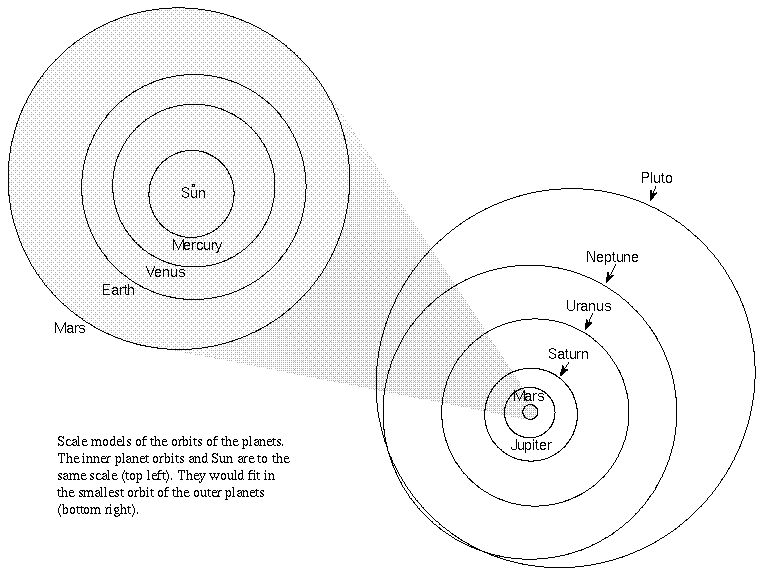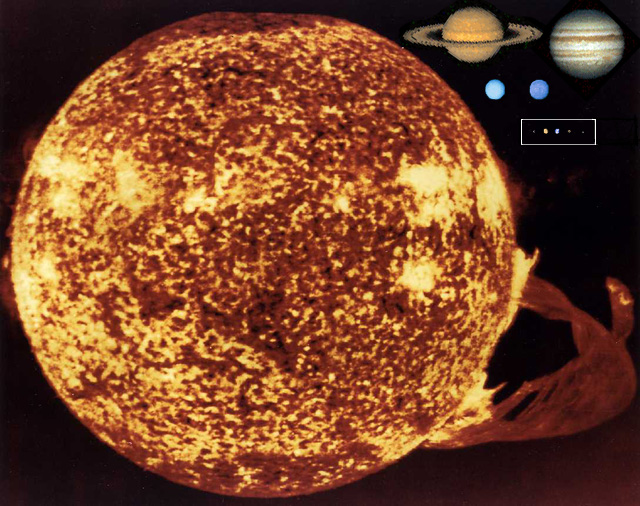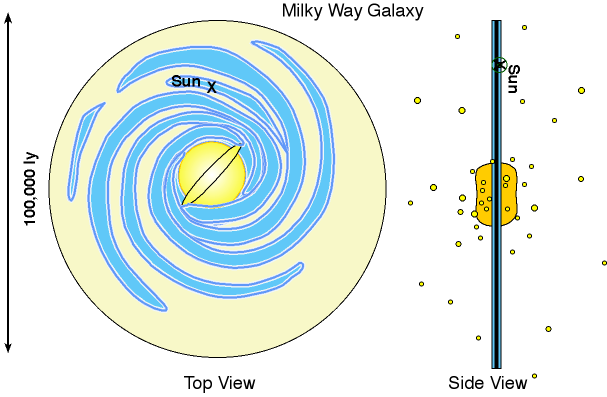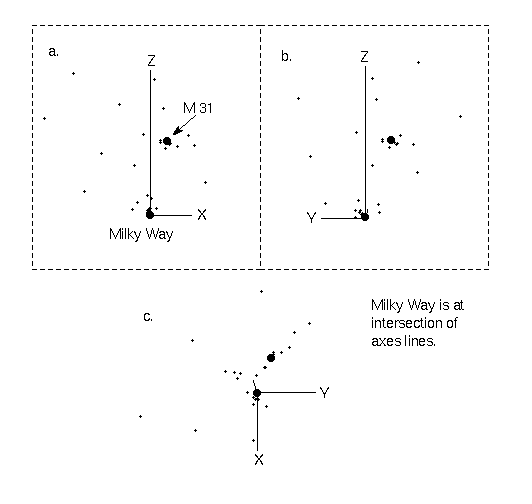
Video lecture for this chapter
You probably already know that the universe is big but most people do not realize how B I G it really is. Many astronomy classes start off with a tour of the universe based on the excellent short film called Powers of Ten by Charles and Ray Eames (link appears in a new window) or a recent "cover" of it such as the Cosmic Eye (link appears in a new window). The film starts with a man and woman in a city park and then expands the field of view by ten times every ten seconds until it reaches the bounds of the observable universe. After zooming back to the man and woman in the park, the field of view is reduced by ten times every ten seconds until one proton in a carbon atom in the man's hand fills the screen. The film is longer than one might first expect because of all of those powers of ten that must be counted to include all of the things astronomy covers.

Another way to give you a sense of the distances between things is to use a proportional (``scaled'') model. In such a model, everything is reduced by the same amount, so all parts of the model relative to each other are of the same proportional size. (In the same way a good trail map you use for hiking or the road map you use for driving is a flat scaled model of the terrain you are moving over.) To create a scale model, divide all of the actual distances or sizes by the same scale factor (in the example below the scale factor is 8,431,254,000), so the scaled distance = (actual distance)/(scale factor).
For our scale model, let us use a yellow mini-basketball about 16.51 centimeters (6.5 inches) across to represent the Sun and then pace out how far the tiny planets would be in this scale model. Since the real Sun is 1,392,000 kilometers (865,000 miles) across, the scale model has all of the planets and distances reduced by an amount equal to (139,200,000,000 / 16.51) = 8,431,254,000 times. The largest planet, Jupiter, would be only 1.7 centimeters across (a dime) and about 92.3 meters away. Our little Earth (a grain of sand) would be closer: ``only'' 17.7 meters (about 18 big steps) away. Our Sun is much larger than the planets, and, yet, it is just a typical star! Here is a scaled model of our solar system:
| Object | Real Diameter (km) | Real Distance (million km) | Scaled Size (cm) | Scaled Distance (m) |
|---|---|---|---|---|
| Sun | 1,392,000 | |
16.51 | |
| Mercury | 4880 | 57.910 | 0.058 (tiny! grain of sand) | 6.9 (7 big steps) |
| Venus | 12,104 | 108.16 | 0.14 (grain of sand) | 12.8 (13 big steps) |
| Earth | 12,742 | 149.6 | 0.15 (grain of sand) | 17.7 (18 big steps) |
| Mars | 6780 | 228.0 | 0.08 (almost 1 mm) | 27.0 (27 big steps) |
| Jupiter | 139,822 | 778.4 | 1.7 (a dime) | 92.3 (92 big steps) |
| Saturn | 116,464 | 1,427.0 | 1.4 (a button) | 169.3 (169 big steps) |
| Uranus | 50,724 | 2,869.6 | 0.6 (button snap) | 340.4 (340 big steps) |
| Neptune | 49,248 | 4,496.6 | 0.6 (button snap) | 533.3 (533 big steps) |
| Pluto | 2274 | 5,913.5 | 0.03 (small piece of dust) | 701.4 (701 big steps) |
| Oort Cloud | |
11,200,000 | |
1,328,400 (1,328 km) |
| Proxima Centauri | 375,840 | 40,493,000 | 4.5 (handball) | 4,802,700 (4,803 km) |
I will usually use the metric system in this text. This system is used by every major country in the world except the United States. The United States will eventually adopt this system. Readers in the U.S. can multiply the kilometer numbers by 0.6 to get the number of miles and multiply the centimeter numbers by 0.4 to get the number of inches. Here is a picture of the planet orbits to help you visualize the vast scales of just the solar system.

The Oort Cloud is a huge spherical cloud of trillions of comets surrounding the Sun that is about 7.5 to 15 trillion kilometers across. In our scale model, the middle of the Oort Cloud would be about the distance between Los Angeles and Denver. Proxima Centauri is the closest star to us outside of the solar system (remember that the Sun is a star too!). Proxima Centauri would be from Los Angeles to beyond the tip of the state of Maine on this scale model (from Los Angeles to New Glasgow, Nova Scotia to be more precise!). In our fastest rocket ships (neglecting the Sun's gravity) it would take almost 70,000 years to reach Proxima Centauri!
Instead of using ridiculously small units like kilometers, astronomers use much larger distance units like an astronomical unit to describe distances between the planets and a light year to describe distances between the stars. An astronomical unit = the average distance between the Earth and the Sun, or about 149.6 million kilometers. For example, Jupiter is (778.4 million km)/(149.6 million km) = 5.203 astronomical units from the Sun. A light year is how far light will travel in one year. The distance D something travels in a given time interval t is found by multiplying the speed v by the time interval. In compact math notation this is: D = v×t. You can find out how many kilometers a light year is by multiplying the speed of light by a time interval of one year:
1 light year = (299,800 kilometers/second) × (31,560,000 seconds/year) = 9,461,000,000,000 kilometers (9.461 trillion kilometers---several tens of thousands of times larger than even the astronomical unit!).
The nearest star is about 4.3 light years away which means that it takes light 4.3 years to travel from Proxima Centauri to Earth. The rest of the stars are further away than that! The speed of light is the fastest speed possible for anything in the universe to travel despite what you may see in science fiction movies or books. It is because of the H-U-G-E distances and l-o-n-g times it would take extraterrestrial spacecraft to travel to the Earth that many astronomers are skeptical about extraterrestrial beings abducting humans.
The Sun is one star among over 200 billion stars gravitationally bound together to make the Milky Way Galaxy. A galaxy is a very large cluster of billions of stars held together by the force of their mutual gravity on each other. That definition is a loaded one that will be unpacked and examined in more detail in later chapters, but for now let us continue on our brief tour of the universe. The Milky Way is a flat galaxy shaped like a pancake with a bulge in the center. Stars and gas are clumped in spiral arms in the flat disk part of the Galaxy. Many stars are also found in between the spiral arms. Our solar system is in one of the spiral arms of the Milky Way and is about 27,000 light years from the center of the galaxy. The entire Milky Way is about 100,000 light years across. In our scaled model with the Sun 16.51 centimeters across, the Milky Way would be about 112 million kilometers across or about 38% of the size of the Earth's orbit around the Sun. Recall that Pluto's orbit is only 1.4 kilometers across on this scale---the Galaxy is MUCH larger than our solar system! Here is an artist's view of our galaxy with the Sun's position marked (note that our entire solar system would be smaller than the smallest dot visible in the picture!):

Let's reduce our scale model even more so that our galaxy is the size of the mini-basketball. The closest other galaxy is a small irregularly-shaped one about 13 centimeters away from the Sun toward the direction of the Milky Way's center. It is about the size of a cooked, fat breakfast sausage link in our scale model. Appropriately, the Milky Way is in the process of gobbling up this galaxy. Two famous satellite galaxies of the Milky Way called the Large Magellanic Cloud and Small Magellanic Cloud are about 30 centimeters and 35 centimeters away, respectively. The Large Magellanic Cloud is about the size of a tennis ball and the Small Magellanic Cloud is about the size of a ping pong ball. The Andromeda Galaxy is the closest large galaxy to the Milky Way: a ball 19 centimeters in diameter (a volleyball) about 4.8 meters away. The Milky Way and the Andromeda Galaxy are at either end of a group of about 30 galaxies gravitationally bound together in the Local Group. The Local Group can be roughly divided into two clumps with each clump having a large spiral in it: the Milky Way and the Andromeda Galaxy. Here are three views of the Local Group, each viewed from a position 90 degrees different from the rest. The Milky Way is the large dot at the intersection of the x,y,z axes and the Andromeda Galaxy is the other large dot.

The closest large cluster of galaxies is called the Virgo cluster (toward the direction of the Virgo constellation). The Virgo cluster has over 1000 galaxies in it and is roughly 50 meters away in our scale model. Notice that compared to their size, the galaxies are relatively close to one another. Stars inside a galaxy are relatively very far apart from one another compared to the sizes of the stars. You will see that the relative closeness of the galaxies to each other has a significant effect on the development of galaxies.
The Local Group and Virgo cluster are part of a larger long, narrow group called the Local SuperCluster, sometimes called the Virgo Supercluster since the Virgo cluster is close to the middle. The Local Group is close to one edge of the Local SuperCluster. In our scale model with the Milky Way the size of a mini-basketball, the Local Supercluster is about 190 meters long and the entire observable universe is about 49.5 kilometers in diameter.
![]()
Select the image to see the graphic that illustrates how far Proxima Centauri is from us.
The scale models described above are just a few of the many you will find on the internet. In the next section, a scale model for Time will be given. Before you go there, though, check out Nikon's "Universcale" that goes from the nanoworld to the universe in a very cool way (link will appear in a new window) or see Josh Worth's "If the Moon Were Only 1 Pixel" for a scale model of the solar system. Another page to check out for getting some perspective on our location and size in the universe is The Known Universe from the American Museum of Natural History (link appears in a new window and view the embedded YouTube six-minute video). Finally, Alex Gorosh & Wylie Overstreet posted a video of their construction of a true scale model of the solar system out to Neptune on a dry lake bed in Nevada.
![]() Go back to previous section --
Go back to previous section --
![]() Go to next section
Go to next section
last updated: November 26, 2021